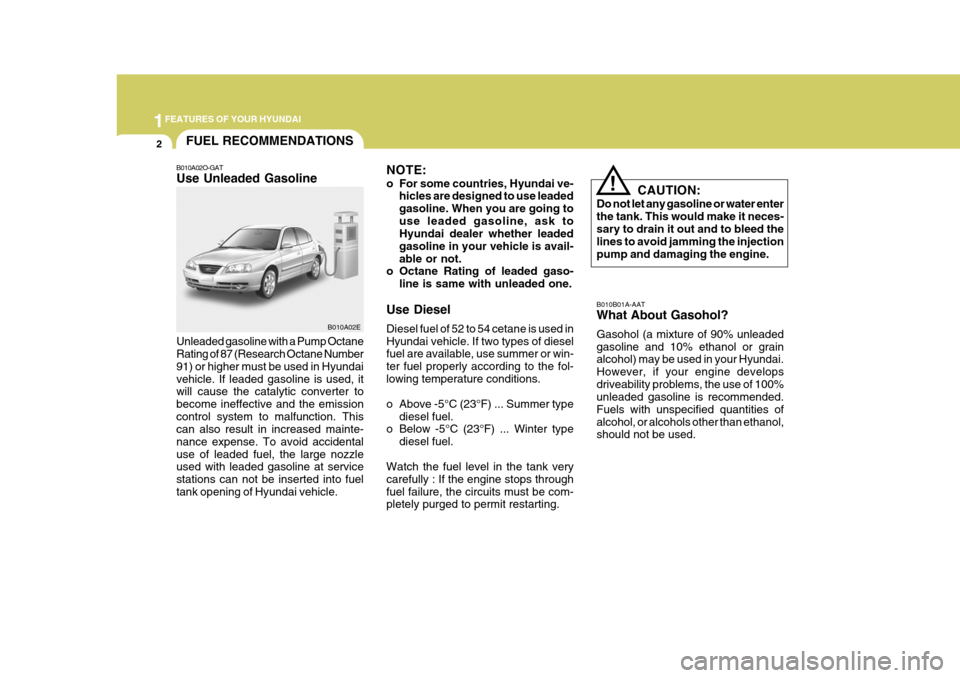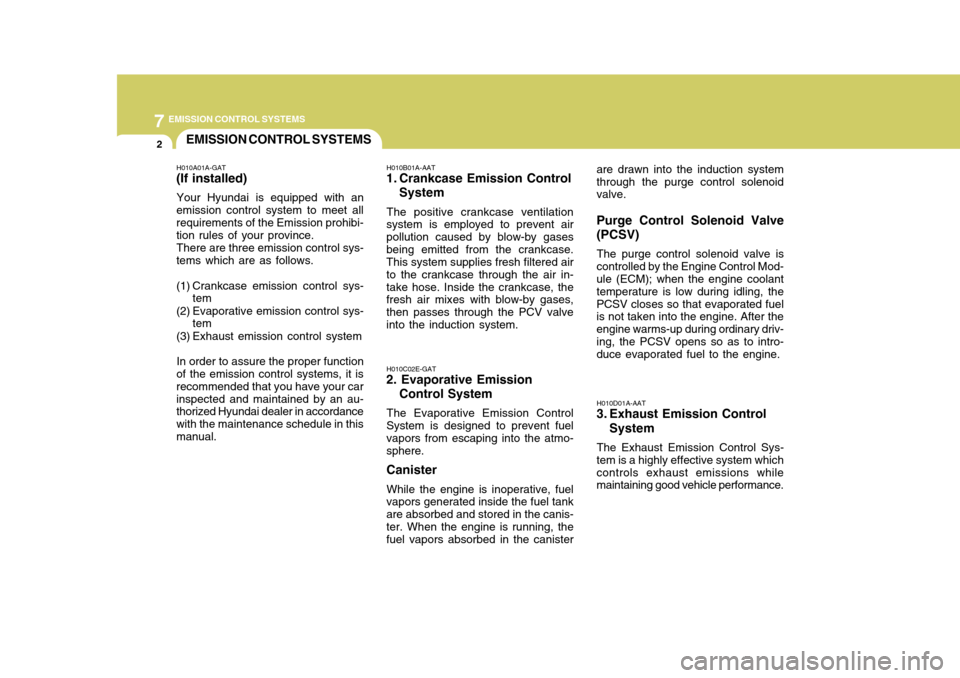open gas tank Hyundai Elantra 2006 Owner's Manual
[x] Cancel search | Manufacturer: HYUNDAI, Model Year: 2006, Model line: Elantra, Model: Hyundai Elantra 2006Pages: 277, PDF Size: 10.18 MB
Page 16 of 277

1FEATURES OF YOUR HYUNDAI
2
B010B01A-AAT What About Gasohol? Gasohol (a mixture of 90% unleaded gasoline and 10% ethanol or grain alcohol) may be used in your Hyundai. However, if your engine developsdriveability problems, the use of 100% unleaded gasoline is recommended. Fuels with unspecified quantities ofalcohol, or alcohols other than ethanol, should not be used.
B010A02O-GAT Use Unleaded Gasoline Unleaded gasoline with a Pump Octane Rating of 87 (Research Octane Number 91) or higher must be used in Hyundaivehicle. If leaded gasoline is used, it will cause the catalytic converter to become ineffective and the emissioncontrol system to malfunction. This can also result in increased mainte- nance expense. To avoid accidentaluse of leaded fuel, the large nozzle used with leaded gasoline at service stations can not be inserted into fueltank opening of Hyundai vehicle. NOTE:
o For some countries, Hyundai ve-
hicles are designed to use leaded gasoline. When you are going touse leaded gasoline, ask to Hyundai dealer whether leaded gasoline in your vehicle is avail-able or not.
o Octane Rating of leaded gaso-
line is same with unleaded one.
Use Diesel Diesel fuel of 52 to 54 cetane is used in Hyundai vehicle. If two types of diesel fuel are available, use summer or win- ter fuel properly according to the fol-lowing temperature conditions.
o Above -5°C (23°F) ... Summer type diesel fuel.
o Below -5°C (23°F) ... Winter type
diesel fuel.
Watch the fuel level in the tank very carefully : If the engine stops throughfuel failure, the circuits must be com- pletely purged to permit restarting. CAUTION:
Do not let any gasoline or water enter the tank. This would make it neces-sary to drain it out and to bleed the lines to avoid jamming the injection pump and damaging the engine.
!
B010A02E
FUEL RECOMMENDATIONS
Page 259 of 277

7EMISSION CONTROL SYSTEMS
2EMISSION CONTROL SYSTEMS
H010A01A-GAT
(If installed)
Your Hyundai is equipped with an
emission control system to meet all requirements of the Emission prohibi- tion rules of your province.
There are three emission control sys-
tems which are as follows.
(1) Crankcase emission control sys- tem
(2) Evaporative emission control sys- tem
(3) Exhaust emission control system
In order to assure the proper function
of the emission control systems, it is recommended that you have your carinspected and maintained by an au- thorized Hyundai dealer in accordance with the maintenance schedule in thismanual. H010B01A-AAT
1. Crankcase Emission Control
System
The positive crankcase ventilation
system is employed to prevent airpollution caused by blow-by gasesbeing emitted from the crankcase. This system supplies fresh filtered air to the crankcase through the air in-take hose. Inside the crankcase, the fresh air mixes with blow-by gases, then passes through the PCV valveinto the induction system.
H010C02E-GAT
2. Evaporative Emission
Control System
The Evaporative Emission Control
System is designed to prevent fuel vapors from escaping into the atmo- sphere. Canister
While the engine is inoperative, fuel
vapors generated inside the fuel tank are absorbed and stored in the canis-ter. When the engine is running, the fuel vapors absorbed in the canister are drawn into the induction system through the purge control solenoid valve. Purge Control Solenoid Valve (PCSV)
The purge control solenoid valve is
controlled by the Engine Control Mod- ule (ECM); when the engine coolant temperature is low during idling, thePCSV closes so that evaporated fuel is not taken into the engine. After the engine warms-up during ordinary driv-ing, the PCSV opens so as to intro- duce evaporated fuel to the engine.
H010D01A-AAT
3. Exhaust Emission Control
System
The Exhaust Emission Control Sys-
tem is a highly effective system which controls exhaust emissions while maintaining good vehicle performance.